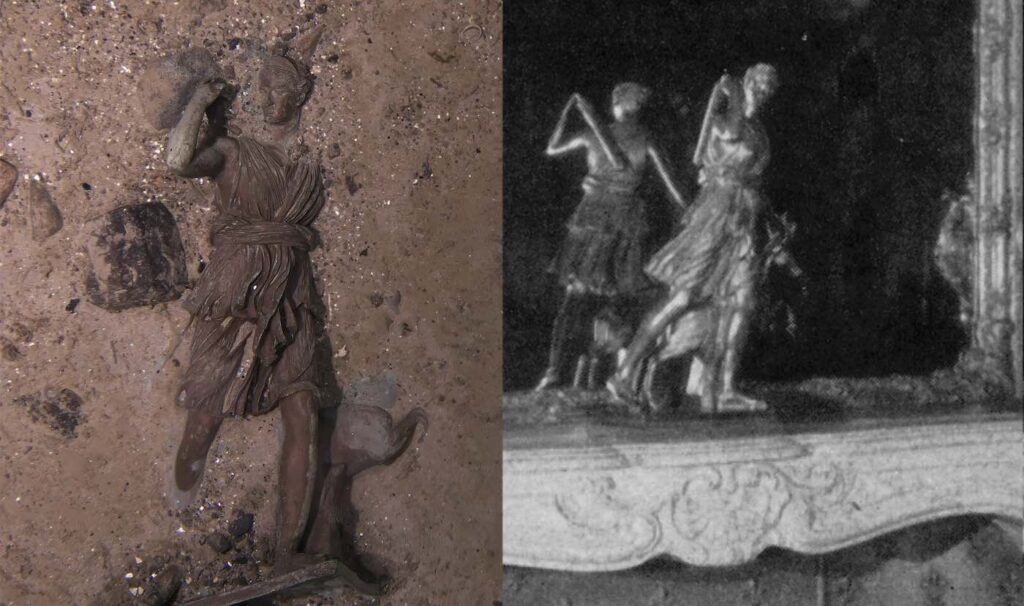The Titanic’s story has been told countless times, but new discoveries still bring fresh insights into the luxury and tragedy that surrounded the fateful voyage. One of the most recent—and astonishing—finds on the ocean floor has turned out to be a long-lost statue of the Diana of Versailles, believed to have sunk with the ship over a century ago. The rediscovery of this classical artwork not only reshapes our understanding of the Titanic’s cultural significance but also adds another layer to the ship’s already mythic narrative. This remarkable find raises numerous questions about art, history, and the nature of preservation beneath the sea.
The Mythic Diana of Versailles
The Diana of Versailles, a Roman copy of a Greek original dating back to the 4th century BCE, is a larger-than-life statue that depicts Diana (Artemis in Greek mythology), the goddess of the hunt, accompanied by a stag. The statue is celebrated for its grace and dynamic form, symbolizing Diana’s power and connection with the natural world. The original Diana of Versailles has been housed at the Louvre in Paris since the 17th century, but many replicas were made, and some were displayed in private collections and public spaces around the world.
It was long suspected that a particularly fine replica of the statue, one admired for its craftsmanship and grandeur, had been aboard the Titanic as part of the ship’s impressive array of art and luxury goods. However, for more than a century, its whereabouts remained a mystery, buried beneath the cold waters of the North Atlantic. Its rediscovery, resting on the ocean floor near the wreck of the Titanic, has reignited interest in the intersection of art history and maritime archaeology.
A Journey of Luxury—and Loss
The presence of such an exquisite statue aboard the Titanic speaks to the opulence that defined the ship and its passengers. The Titanic was not merely a means of transportation; it was a floating palace, outfitted with the finest amenities, from ornate dining rooms to grand libraries. Wealthy passengers brought with them not only their personal belongings but also valuable artworks, furniture, and other prized possessions.
The Diana statue, believed to have been part of a private collection en route to the United States, was a testament to the era’s appetite for classical art and culture. The statue’s owner, rumored to be an American millionaire with an affinity for European antiquities, intended to display it in a mansion or gallery upon arrival in New York. However, the tragic sinking of the Titanic sealed its fate—or so it was thought until its recent rediscovery.
The Discovery: Science Meets Art
The discovery of the Diana of Versailles replica is the result of years of meticulous underwater exploration. Since the Titanic wreck was first located in 1985, numerous expeditions have ventured to the site, each revealing new artifacts and insights into the ship’s final moments. Using state-of-the-art remotely operated vehicles (ROVs) and sonar mapping, oceanographers and archaeologists have scoured the wreckage, uncovering everything from delicate china to the ship’s grand boilers.
The Diana statue was discovered during one such expedition, buried under sediment but remarkably intact given its long stay at the bottom of the ocean. Initial sonar scans revealed a large object resembling a human figure near the stern of the ship. Closer inspection using underwater cameras confirmed the presence of the statue, its form partially obscured by the buildup of marine life and debris. Despite the corrosive conditions of the ocean, the statue’s marble construction helped it withstand the harsh environment far better than many of the ship’s metal components.
The discovery has raised new questions about the logistics of art transport aboard the Titanic. Historians are now examining how such a large and valuable piece came to be on the ship, what role it played in the lives of its owners, and how many other lost works of art might still lie undiscovered at the bottom of the sea.
The Titanic’s Cultural Legacy
The rediscovery of the Diana of Versailles replica enhances the Titanic’s already rich cultural legacy. Over the past century, the Titanic has become a symbol of human ambition, tragedy, and the ephemeral nature of life. The addition of the lost statue underscores the idea that the ship was not just a vessel for people but also a carrier of culture, art, and history.
The Titanic disaster has always captured the public imagination, but its cultural significance extends beyond the lives lost. The ship’s sinking marked the end of an era defined by boundless optimism, industrial achievement, and the belief in human mastery over nature. The inclusion of classical artwork, like the Diana statue, aboard the Titanic speaks to the ship’s identity as a floating symbol of civilization’s finest achievements, now juxtaposed with the raw power of the natural world that claimed it.
The statue itself, a symbol of strength, beauty, and nature, mirrors many of the themes that resonate in the Titanic’s story. Diana, the huntress, represents independence and survival, yet her marble form lay undisturbed in the ocean’s depths for over a century. This metaphorical connection between the ship’s narrative and the statue’s subject matter adds a new layer of meaning to the tragedy and its long-lasting impact on popular culture.
Challenges of Preservation
While the rediscovery of the Diana statue is thrilling, it presents significant challenges for preservation and potential recovery. Objects that have been submerged in saltwater for extended periods often require extensive conservation efforts to prevent further deterioration once they are brought to the surface. In the case of the statue, its marble composition makes it more resilient than other materials, but it is still susceptible to damage if not handled properly.
Marine archaeologists and conservators are now faced with the task of determining the best course of action for the statue. Should it be left on the ocean floor as part of the Titanic’s preserved site, or should it be recovered and restored for public display? These are difficult questions that involve balancing the historical value of leaving artifacts in situ with the desire to share such a significant find with the world.
A New Chapter in Titanic Archaeology
The discovery of the Diana of Versailles replica opens a new chapter in Titanic archaeology. While many artifacts have been recovered and displayed in museums, this find highlights the potential for further exploration and discovery. The Titanic wreck site still holds many secrets, and each new artifact recovered adds to the complex tapestry of its history.
As scientists and historians continue to analyze the statue and its implications, there is a renewed sense of excitement surrounding the Titanic. The rediscovery serves as a reminder that the ship’s story is far from over. There are still untold treasures lying beneath the waves, waiting to be uncovered and studied. Each find deepens our understanding of the people, culture, and world that came together aboard the Titanic.
The Intersection of Art and Tragedy
The rediscovery of the Diana of Versailles statue on the ocean floor where the Titanic sank adds a poignant new dimension to the ship’s legacy. More than just a luxury liner, the Titanic carried with it symbols of human achievement and cultural significance. The statue’s survival, lying untouched in the depths for over a century, serves as a powerful metaphor for the endurance of art and history even in the face of tragedy.
This discovery not only enhances our understanding of the Titanic’s place in cultural history but also invites reflection on the fragile relationship between human ambition and the forces of nature. As the statue is studied and possibly restored, it will stand as a reminder of the Titanic’s enduring mystique and its place in the collective memory of the world.
No comments yet.







